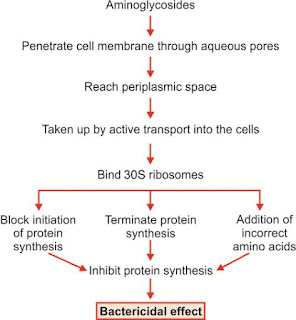MOA OF AMINOGLYCOSIDE ANTIBIOTICS
MOA of Aminoglycoside Antibiotics
Aminoglycosides
exert their bactericidal effect by inhibiting protein synthesis in bacteria and compromising the structure of the bacterial cell wall.
Aminoglycoside Antibiotics
Aminoglycoside
antibiotics are used to treat serious infections caused by gram-negative bacteria.
Some commonly used aminoglycosides include:
amikacin (Amikin®);
apramycin;
capreomycin;
gentamicin (Garamycin®); kanamycin (Kantrex®); neomycin (Mycifradin®);
netilmicin
(Netromycin®); paromomycin (Humatin®);
streptomycin;
tobramycin (TOBI Solution®, TobraDex®, Nebcin®)
Mode
of Action
Although aminoglycosides stop bacteria from making proteins, it is uncertain whether this is the action that results in
bacterial cell death.
Disruption of Protein Synthesis
Aminoglycosides bind to the bacterial 30S ribosomal subunit. Ribosomes are the protein factories of cells. They are composed of two subunits in bacteria, the 30S and a larger 50S. By binding to the ribosome, aminoglycosides inhibit the translocation of
tRNA during translation and leaving the bacterium unable
to synthesize proteins necessary for growth.
Although the eukaryotic cells
of humans also
have ribosomes, these cellular
protein factories differ
in size and structure from the ribosomes of prokaryotes. That
is why aminoglycosides do not interfere with protein
synthesis in human cells.
Bacterial Cell Wall Damage
It may not be the inhibition of protein synthesis that produces the bactericidal (bacteria-killing) effect.
Aminoglycosides
also appear to displace cations in the bacterial cell biofilm that are
responsible for linking the
lipopolysaccharide (LPS)
molecules characteristic of
Gram-negative bacterial
cell walls.
This creates
holes in the cell wall
that may kill
the bacteria before the aminoglycoside even reaches the ribosome. Because
our cells do not have cell walls (some
of the chemical structural components of the bacterial cell wall are found
only bacteria) human
cells are not susceptible to these destructive actions.
Type
of Infection Aminoglycosides Are Used Against
Aminoglycosides
are most often used in empiric therapy (treatment initiated before a firm diagnosis is made) for serious infections
including septicemia, complex infections
within the abdominal cavity, severe urinary tract infections, and nosocomial
(hospital-acquired) respiratory infections.
Because of their toxicity,
aminoglycosides are only
given for only a short period
of time. Less toxic antibiotics are substituted once the causative agent of infection is positively identified.
Antimicrobial Spectrum of Aminoglycosides
Gram-negative Aerobic Bacteria: Aminoglycosides exert
their
antibiotic effect against aerobic (oxygen requiring), gram-negative
bacteria,
including Pseudomonas, Acinetobacter, and Enterobacter.
Gram-positive Bacteria: Gram-positive bacterial infections can also be treated with aminoglycosides,
but are typically not used because of
the toxicity.
Aminoglycosides have a synergistic the effect when combined with beta-lactam antibiotics (penicillins) and have been
used to treat
streptococcal infections. The ampicillin (a beta-lactam antibiotic)
gentamicin combination is referred
to as "amp and gent" or "pen
and gent" for penicillin and gentamicin.
Mycobacteria: Some
species of Mycobacteria, including the causative agent of tuberculosis,
are also susceptible to aminoglycosides.
Adverse Effects of
Aminoglycosides =Because aminoglycosides are quickly broken down in the
stomach, these antibiotics can't be given orally, but instead
must be injected.
The adverse effects of
aminoglycosides include potential
damage to the ears
and kidneys. The risk can
be reduced by monitoring blood levels of the drug
and maintaining the dose at levels
that will kill
bacteria without causing harmful side effects.

Comments